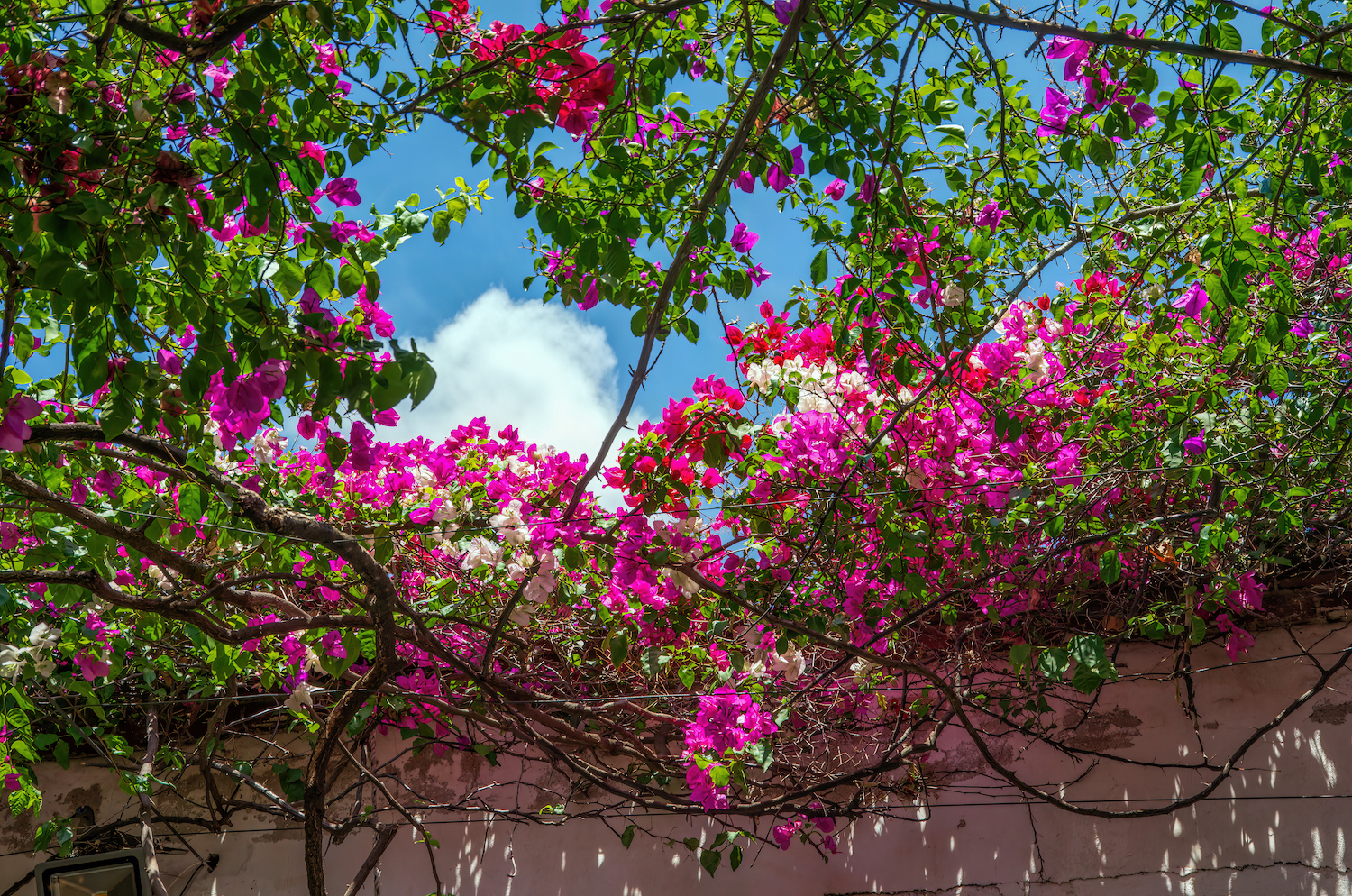Drought-Tolerant Climbing Vines — 7 Plants That Thrive in Summer and Dry Climates
These hardy creepers are a dry gardener's ultimate companion and, best of all, they add a whole lot of color and foliage


Long hours of sunshine and dry climates are customary for most summer-prone regions. And while we certainly find this kind of weather enjoyable, our plants might not seem to like it as much.
However, not all plants despise dry climates. So if you find your foliage faltering, it might be time to swap them out for some drought-tolerant plants instead. If you're wondering what to plant to maintain your home's rustic vine-covered walls, we've got you covered.
We spoke to the experts and they've shared their top recommendations for climbing vines that are beautiful and low maintenance. So you won't have to worry about wilting vines any longer.
The Best Drought-Tolerant Climbing Vines
Drought-tolerant shrubs are perfect for those low maintenance garden ideas. They're also absolutely beautiful and add an abundance of color and brightness to the exterior of your home.
So without further ado, here are 7 best drought-tolerant climbing vibes — according to gardening experts.
1. Wisteria

When it comes to fast-growing climbing plants for privacy, you can't go wrong with wisteria. Landscaping expert Ward Dilmore tells us that wisteria is one of his top choices for drought-tolerant creeping vines that are easy to establish.
"Wisteria is a popular flowering vine that is commonly grown in warm and cool climates," notes Ward. "And it has large purple or white blooms that flower in late spring." When wisteria matures, Ward tells us that it can get quite heavy and difficult to control. So he recommends growing wisteria on arbors or architecture that can waistband the weight of a large heavy vine.
The Livingetc newsletters are your inside source for what’s shaping interiors now - and what’s next. Discover trend forecasts, smart style ideas, and curated shopping inspiration that brings design to life. Subscribe today and stay ahead of the curve.
Hardiness Zones: 5 - 9
2. Bougainvillea

Drought-tolerant creeping vines don't have to be drab hardy plants that offer plain foliage to your backyard. In fact, they can be quite exotic. One of the key plants associated with Mediterranean garden ideas is bougainvillea, and it happens to be surprisingly drought-tolerant and incredibly stunning.
Gardening expert Allison Jacob tells us that this showstopper is all about color. "Its flowers pop in shades of pink, purple, red, or white, brightening up any dull corner," she says. "And it's a sun-worshipper and likes its soil well-drained."
To keep Bougainvillea happy, Allison recommends making sure it gets plenty of sun - at least 5-6 hours a day. "When it comes to water, less is more," she notes. "Give it a good soak, then let the soil dry out before watering again." She adds that this tough-love approach actually encourages better blooming.
Hardiness Zones: 9 - 11
3. Creeping Fig

Creeping fig is a self-clinging vine that is among the top contenders for the best plants to cover a fence. Ward tells us that this climbing vine is resilient to dry climates and also bears purple fruit upon establishment.
He explains that creeping fig features small leaves with dense growth that can hide a desired wall within just a few seasons. "This is a popular choice of vine for stucco walls and stone siding on houses," he says. "They can easily cover a wall very quickly and are very easy to control."
Hardiness Zones: 8 - 11
4. Arizona Grape Ivy

In conversation with Allison, she tells us that Arizona grape ivy is a speedy grower that shoots up to 30 feet, perfect for covering big spaces fast. "It's not picky about light, thriving in full sun or partial shade," she says. "And you'll love its unique leaves - they're rubbery and split into three parts, each about 4 inches long."
While they may not be outright vibrant, these pretty vines are a great option for fairy-tale garden plants that act as filler. As a bonus, Allison tells us that it sprouts tiny flowers that turn into grape-like fruits. "Don't forget to give it something to climb on, like a fence or trellis," he says. "Once it's up and running, you might need to trim it now and then to keep it in check."
Hardiness Zones: 6 - 11
5. Honeysuckle

If you're looking for climbing plants for the front of your house, Allison encourages giving honeysuckle a go. "This classic vine not only looks good but smells amazing too," she says. "And it's a hit with bees and butterflies, so you'll be doing your local pollinators a favor."
To keep it looking its best, Allison encourages gardeners to give it a haircut after it flowers. She tells us that this encourages bushier growth and keeps it from taking over your whole garden. While honeysuckle is tough, it's not invincible. So she suggests keeping an eye out for pests and diseases. "With these hardy vines, you can create a lush, green oasis without turning on the sprinklers every day," she says.
Hardiness Zones: 5 - 9
6. Clematis Armandii

Sunny drought-friendly gardens are usually met with tons of heat. In such cases, it's always a good idea to give your garden some climbing plants for shade. Gardening expert Ben McInerney tells us that this evergreen clematis is his personal favorite. "I've used it to create year-round privacy screens that thrive on neglect," he notes. "And its fragrant white flowers in spring are an added bonus."
Ben tells us that what sets clematis armandii apart is its ability to retain leaves year-round in milder climates. "I've successfully used it to soften the look of pergolas and arches," he says. "And it also provides a lush green backdrop even in winter."
Hardiness Zones: 6 - 9
7. Passion Flower

If fauna-friendly gardens are on your backyard mood board for the season, passion flower happens to be one of the best plants for wildlife. Not only do they feature intriguing blooms but they're also known for their drought-tolerance
Ben tells us that passiflora is on his list of low-maintenance hardy vines because of its incredible resilience. "In one particularly challenging project, I planted passion flower vines in a south-facing, baked clay soil area," he recalls. "Not only did they survive, but they also produced their exotic, alien-like flowers throughout the summer."
Hardiness Zones: 6 - 10
FAQS
What of these drought-tolerant climbing vines is easiest to grow?
Out of all these bright and colorful blooms, clematis is the easiest climbing plant to grow. Its drought-tolerant properties and bright foliage is sure to make an impression. They flower from early spring to the mid-summer, and best of all — they require minimal pruning. But please do prune your blooms if you notice any damage or disease.
So if you're looking to add these flowers into your backyard, we approve!
With your list of drought-tolerant climbing vines ready to go, you can plant a garden that doesn't require plenty of maintenance. Instead of worrying about watering your crops and shielding them from the sun, you can sit back, relax, and watch your vines flourish.

Amiya is a Home Wellness Writer at Livingetc. She recently graduated with a Masters Degree in Magazine Journalism from City, University of London, and has lent her words to beauty, fashion, and health sections of lifestyle publications including Harper’s Bazaar and Women’s Health. Her experience as a research analyst has equipped her with an eye for emerging trends. When she’s off the clock, she can be found reading, listening to music, or overanalyzing her latest Co-Star update.






